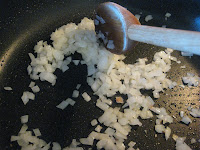I love eggs in just about any form, so it's inevitable that they show up on my table at all times of day. It doesn't hurt that they are so easy to prepare, which is a nice break from some of the other cooking projects I've had during the holidays. Sometimes I make bacon, egg and cheese sandwiches. Sometimes I have soy sauce eggs with rice or noodles. And then sometimes I bake quiche.
The first time I tasted quiche was in my seventh grade French class. Our teacher, Mrs. D, wanted us to absorb some culture as well as conjugations. She perched a beret over her curly auburn hair (it was clichéd even back then, although adorable on Mrs. D), read French poetry, played French records (so help me, I'll slap anyone who asks me what records are), and brought in Evian water and Brie cheese (they were exotic at the time). She also fed us quiche.
Since then, quiches have become hip, then passe, and now ... I don't know what their current status is, and I don't care. Just let me have the eggy, custardy, cheesy filling in a buttery crust. Did I mention the bacon? I'll be quiet for the two minutes it takes to inhale my share.
 |
| Ham and cheese quiche with broccoflower gratin and braised leek |
I've made some pretty good crusts, but I'm still experimenting. A recipe that I've been tinkering with for several months replaces one-third of the butter with olive oil (see recipe below). The olive oil helps coat the flour for a more tender crust. It's also more healthful, not that I'm afraid of a little butter or cream, as you can see from the quiche ingredients.
The vodka adds moisture to the dough without helping the gluten form. Gluten, which forms when water mixes with wheat flour, means structure, but it can also contribute to toughness. The vodka wasn't my innovation. A few years ago, Cook's Illustrated published a vodka pie dough recipe that attracted a lot of attention. For me, that dough was a little too wet and sticky to work with. But the idea of using vodka was good, so I incorporated that into my own crust.
Spinach-Bacon Quiche Recipe
Serves 4 adults
INGREDIENTS
1 crust (recipe below)
1 cup shredded cheese (I like to use a combination of cheddar and swiss)
1 package (10 ounces) of frozen chopped spinach, drained*
4 to 5 slices of cooked bacon, crumbled (or 1/2 cup chopped ham)
6 large eggs**
1/2 cup heavy cream (or creme fraiche)
1 cup milk
1/2 teaspoon salt
1/2 teaspoon freshly ground pepper
DIRECTIONS
1. Preheat oven to 425 degrees F. Bake crust (recipe below).
2. While crust is baking, cook spinach, then squeeze out liquid. After removing crust from oven, immediately sprinkle half to two-thirds of the shredded cheese all over the bottom of the crust and allow to cool on rack. Lower oven to 375 degrees F.
With fingers, break up the spinach and sprinkle it evenly all over the bottom of the crust. Drop bacon pieces evenly over the spinach, then the rest of the shredded cheese.
3. In a 4-cup measuring cup or in a mixing bowl, beat eggs. Add cream, milk, salt and pepper, and beat until combined. Pour mixture into the crust, taking care not to overfill. Depending on the size of the pie dish, you may have extra filling.
4. Place quiche on a baking sheet, then bake until center barely sets, about 40 to 50 minutes (adjust time depending on the oven). Serve with salad, soup or cooked vegetable. We recently had spinach-bacon quiche with leftover potato gratin and ham and cheese quiche with broccoflower gratin.
 |
| Use ham instead of bacon if that's what you have. |
**Leave out a couple yolks to reduce the cholesterol.
Pie crust recipe for quiche
makes a 9-inch deep-dish bottom crust
INGREDIENTS
2 cups all purpose flour*** (275 grams, or a shade under 9 3/4 ounces)
1/2 teaspoon salt
1 stick (1/2 cup, or 4 ounces) butter, very cold, cut into half-inch cubes
1/4 cup olive oil
5 to 7 Tablespoons ice water (5 Tablespoons worked for me)
1 Tablespoon vodka
1 teaspoon vinegar
DIRECTIONS
1. Put flour and salt in bowl of food processor and pulse to combine. Add half the butter and all the olive oil, and pulse until the butter pieces resemble sand. Scrape down sides of processor bowl if needed. Add remaining butter and process until the butter pieces are about the size of peas. (If you don't have a processor, use your fingers or a pastry cutter to work butter into the flour.)
2. Dump contents of processor into a large (4.5 quart or 5 quart) mixing bowl. Put 5 Tablespoons of the ice water together with the vodka and vinegar in a cup. Using a fork, stir the liquid into the dough until it clumps. Give it a squeeze with a clean hand. If dough crumbles instead of holding together, add water, half Tablespoon at a time. If it holds together, shape into a disk, wrap in plastic and refrigerate at least 30 minutes.
3. After dough has rested, roll out and fit into a 9-inch deep-dish pie plate or a 9- or 10-inch quiche dish. Avoid stretching the dough while placing it in the pie plate or it will be more susceptible to shrinkage. Trim dough about 1/4 inch outside the edge of the pie plate. (I usually have enough extra dough from the trimmings to make a toaster pastry.) Then crimp the edges. Poke bottom with a fork and place in freezer 30 minutes.
4. With the rack in lower third of the oven, preheat oven to 425 degrees F. Bake crust until it turns golden, about 25 minutes. You may have to cover the perimeter with a pie crust protector or foil while the bottom bakes through. If the bottom starts to balloon up, pierce with the tines of a fork and use the back of the fork to press the bottom back down. (I haven't had this problem lately, but it could be just luck. If you want, you can line the crust with buttered foil weighed down with pie weights or dried beans for about the first 15 minutes.)
5. Remove crust from oven and set on a rack.
NOTES: ***I use King Arthur unbleached all purpose flour, which is available at my supermarket. There are other good flours, but if the protein content is different, they may require different amounts of liquid. I recommend weighing ingredients for baking, although I know it isn't always possible or convenient. If using cups to measure flour, I fluff the flour then spoon it into the measuring cup before leveling it with a straight edge, such as a knife.







































